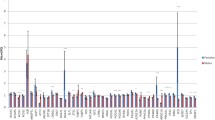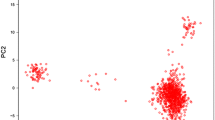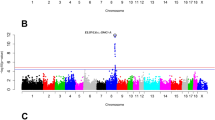Abstract
Current customers’ demands focus on the nutritional and sensory quality of cattle meat. Candidate gene approach allows identification of genetic polymorphisms that have a measurable effect on traits of interest. The aim of this work is to identify new molecular markers for beef production through an association study using 27 candidate genes and 314 purebred bulls from 11 European cattle breeds. Twelve genes were found associated with different lipid and meat quality traits, and among these stand out the considerable effect of CAST on fatness score, CGGBP1 on growth traits, HSPB1 on the percentage of lauric acid (12:0) and phospholipid docosahexaenoic acid (DHA 22:6 n − 3), RORA on the ratio of light absorption (K) to light scattering (S) (K/S), and TNFA on lightness (L*). Most of these traits are related to post-mortem muscle biochemical changes, which are key factors controlling meat quality and consumers’ acceptance. Also, the variations produced on muscle fatty acid profiles, such as those of AANAT, CRH, CSN3, HSPB1, and TNFA, give insights into the genetic networks controlling these complex traits and the possibility of future improvement of meat nutritional quality.
Similar content being viewed by others
References
Givens DI, Gibbs RA (2008) Current intakes of EPA and DHA in European populations and the potential of animal-derived foods to increase them. Proc Nutr Soc 67:273–280
McAfee AJ, McSorley EM, Cuskelly GJ, Moss BW, Wallace JM, Bonham MP, Fearon AM (2010) Red meat consumption: an overview of the risks and benefits. Meat Sci 84:1–13
Hocquette JF, Lehnert S, Barendse W, Cassar-Malek I, Picard B (2007) Recent advances in cattle functional genomics and their application to beef quality. Animal 1:159–173
Aaslyng MD (2009) Trends in meat consumption and the need for fresh meat and meat products of improved quality. In: Kerry JP, Ledward D (eds) Improving the sensory and nutritional quality of fresh meat. Woodhead Publishing Ltd, Cambridge, pp 3–18
Simm G, Lambe N, Bünger L, Navajas E, Roehe R (2009) Use of meat quality information in breeding programmes. In: Kerry JP, Ledward D (eds) Improving the sensory and nutritional quality of fresh meat. Woodhead Publishing Ltd, Cambridge, p 680
Ron M, Weller JI (2007) From QTL to QTN identification in livestock—winning by points rather than knock-out: a review. Anim Gen 38:429–439
Albertí P, Panea B, Sañudo C, Olleta JL, Ripoll G, Ertbjerg P, Christensen M, Gigli S, Failla S, Concetti S, Hocquette JF, Jailler R, Rudel S, Renand G, Nute GR, Richardson RI, Williams JL (2008) Live weight, body size and carcass characteristics of young bulls of fifteen European breeds. Livest Sci 114:19–30
Christensen M, Ertbjerg P, Failla S, Sañudo C, Richardson RI, Nute GR, Olleta JL, Panea B, Albertí P, Juárez M, Hocquette JF, Williams JL (2011) Relationship between collagen characteristics, lipid content and raw and cooked texture of meat from young bulls of fifteen European breeds. Meat Sci 87:61–65
Page BT, Casas E, Heaton MP, Cullen NG, Hyndman DL, Morris CA, Crawford AM, Wheeler TL, Koohmaraie M, Keele JW, Smith TPL (2002) Evaluation of single-nucleotide polymorphisms in CAPN1 for association with meat tenderness in cattle. J Anim Sci 80:3077–3085
White NS, Casas TLE, Wheeler TL, Shackelford SD, Koohmaraie M, Riley DG, Chase CC, Johnson DD, Keele JW, Smith TPL (2005) A new single nucleotide polymorphism in CAPN1 extends the current tenderness market test to include cattle of Bos indicus, Bos taurus, and crossbred descent. J Anim Sci 83:2001–2008
Barendse WJ (2002) DNA markers for meat tenderness. Patent application WO02064820
Buchanan FC, Thue TD, Yu P, Winkelman-Sim DC (2005) Single nucleotide polymorphisms in the corticotrophin-releasing hormone and pro-opiomelanocortin genes are associated with growth and carcass yield in beef cattle. Anim Genet 36:127–131
Kaminski S (1996) Bovine kappa-casein (CASK) gene—molecular nature and application in dairy cattle breeding. J Appl Genet 37:179–196
Blott S, Kim J, Moisio S, Schmidt-Küntzel A, Cornet A, Berzi P, Cambisano N, Ford C, Grisart B, Johnson D, Karim L, Simon P, Snell R, Spelman R, Wong J, Vilkki J, Georges M, Farnir F, Coppieters W (2003) Molecular dissection of a quantitative trait locus: a phenylalanine-to-tyrosine substitution in the transmembrane domain of the bovine growth hormone receptor is associated with a major effect on milk yield and composition. Genetics 163:253–266
Aschaffenburg R, Drewry J (1957) Genetics of the b-lactoglobulins of cow’s milk. Nature 180:376–378
Thue TD, Buchanan FC (2002) Linkage mapping of POMC to bovine chromosome 11. Anim Genet 34:146–160
Barendse WJ, Bunch RJ, Kijas JW, Thomas MB (2007) The effect of genetic variation of the retinoic acid receptor-related orphan receptor C gene on fatness in cattle. Genetics 175:843–853
Barendse WJ (1999) Assessing lipid metabolism. Patent application WO023248
Sevane N, Crespo I, Cañón J, Dunner S (2011) A primer extension assay for simultaneous use in cattle genotype assisted selection, parentage and traceability analysis. Livest Sci 137:141–150
Bates D, Maechler M (2008) The Comprehensive R Archive Network. http://cran.r-project.org/. Accessed Jan 2012
Churchill GA, Doerge RW (1994) Empirical threshold values for quantitative trait mapping. Genetics 138:963–971
Huang DW, Sherman BT, Lempicki RA (2009) Systematic and integrative analysis of large gene lists using DAVID bioinformatics resources. Nat Protoc 4:44–57
Bernard C, Cassar-Malek I, Le Cunff M, Dubroeucq H, Renand G, Hocquette JF (2007) New indicators of beef sensory quality revealed by expression of specific genes. J Agric Food Chem 55:5229–5237
Abbasvali M, Shekarforoush SS, Aminlari M, Ebrahimnejad H (2012) Effects of medium-voltage electrical stimulation on postmortem changes in fat-tailed sheep. J Food Sci 77:S47–S53
Braggins TJ (1996) Effect of stress-related changes in sheepmeat ultimate pH on cooked odor and flavor. J Agric Food Chem 44:2352–2360
MacDougall DB (1982) Changes in the colour and opacity of meat. Food Chem 9:75–88
Kubelka P, Mink K, Swatland HJ (1995) On line evaluation of meat. Technomic editor, Lancaster, p 192
Swatland HJ (2004) Progress in understanding the paleness of meat with a low pH. South Afr J Anim Sci 34(supplement):2
Dunner S, Sevane N, García D, Cortés O, Valentini A, Williams JL, Mangin B, Cañón J, Levéziel H, Levéziel H, GeMQual Consortium (2013) Association of genes involved in carcass and meat quality in fifteen European bovine breeds. Livest Sci 154:34–44
Patel YM, Lane MD (1999) Role of calpain in adipocyte differentiation. Proc Natl Acad Sci USA 96:1279–1284
Orho-Melander M, Klannemark M, Svensson MK, Ridderstrale M, Lindgren CM, Groop L (2002) Variants in the calpain-10 gene predispose to insulin resistance and elevated free fatty acid levels. Diabetes 51:2658–2664
Xia JJ, Berg EP, Lee JW, Yao G (2007) Characterizing beef muscles with optical scattering and absorption coefficients in VIS-NIR region. Meat Sci 75:78–83
Mancini RA, Hunt MC (2005) Current research in meat color. Meat Sci 71:100–121
Liu Y, Chen YR, Ozaki Y (2000) Characterization of visible spectral intensity variations of wholesome and unwholesome chicken meats with two-dimensional correlation spectroscopy. Appl Spectrosc 54:587–594
Ribeca C, Bonfatti V, Cecchinato A, Albera A, Maretto F, Gallo L, Carnier P (2012) Association of polymorphisms in calpain 1, (mu/I) large subunit, calpastatin, and cathepsin D genes with meat quality traits in double-muscled Piemontese cattle. Anim Genet. doi:10.1111/j.1365-2052.2012.02370.x
Sibut V, Hennequet-Antier C, Le Bihan-Duval E, Marthey S, Duclos MJ, Berri C (2011) Identification of differentially expressed genes in chickens differing in muscle glycogen content and meat quality. BMC Genomics 12:112–125
Gao J, Lin H, Song ZG, Jiao HC (2008) Corticosterone alters meat quality by changing pre- and post-slaughter muscle metabolism. Poult Sci 87:1609–1617
Gill JL, Bishop SC, McCorquodale C, Williams JL, Wiener P (2010) Associations between single nucleotide polymorphisms in multiple candidate genes and carcass and meat quality traits in a commercial Angus-cross population. Meat Sci 86:985–993
Thaller G, Kühn C, Winter A, Ewald G, Bellmann O, Wegner J, Zühlke H, Fries R (2003) DGAT1, a new positional and functional candidate gene for intramuscular fat deposition in cattle. Anim Genet 34:354–357
Li C, Zhou G, Xu X, Zhang J, Xu S, Ji Y (2006) Effects of marbling on meat quality characteristics and intramuscular connective tissue of beef Longissimus muscle. Asian-Aust J Anim Sci 19:1799–1808
Singh U, Roswall P, Uhrbom L, Westermark B (2011) CGGBP1 regulates cell cycle in cancer cells. BMC Mol Biol 7:12–28
Singh U, Westermark B (2011) CGGBP1 is a nuclear and midbody protein regulating abscission. Exp Cell Res 317:143–150
Fagali N, Catalá A (2007) The effect of melatonin and structural analogues on the lipid peroxidation of triglycerides enriched in ω-3 polyunsaturated fatty acids. Life Sci 81:299–305
Pérez R, Cañón J, Dunner S (2010) Genes associated with long-chain omega-3 fatty acids in bovine skeletal muscle. J Appl Genet 51:479–487
Casas E, White S, Wheeler TL, Shackelford SD, Koohmaraie M, Riley DG, Chase CC Jr, Johnson DD, Smith TP (2006) Effects of calpastatin and mu-calpain markers in beef cattle on tenderness traits. J Anim Sci 84:520–525
Reardon W, Mullen AM, Sweeney T, Hamill RM (2010) Association of polymorphisms in candidate genes with colour, water-holding capacity, and composition traits in bovine M. longissimus and M. semimembranosus. Meat Sci 86:270–275
Parton RG, Way M, Zorzi N, Stang E (1997) Caveolin-3 associates with developing T-tubules during muscle differentiation. J Cell Biol 136:137–154
Calonge ME (2004) Identificación de genes con expresión diferencial en tejido muscular de bovinos pertenecientes a los tres genotipos de la miostatina (mutación nt821(del11)). PhD Universidad Complutense de Madrid
Solinas G, Summermatter S, Mainieri D, Gubler M, Montani JP, Seydoux J, Smith SR, Dulloo AG (2006) Corticotropin-releasing hormone directly stimulates thermogenesis in skeletal muscle possibly through substrate cycling between de novo lipogenesis and lipid oxidation. Endocrinology 147:31–38
Barroso A, Dunner S, Cañón J (1999) Polimorfismo genético de las lactoproteínas de los rumiantes domésticos-Revisión. Inf Téc Econ Agrar 2:143–179
Marsh DJ, Hollopeter G, Huszar D, Laufer R, Yagaloff KA, Fisher SL, Burn P, Palmiter RD (1999) Response of melanocortin-4 receptor-deficient mice to anorectic and orexigenic peptides. Nat Genet 21:119–122
Lau P, Nixon SJ, Parton RG, Muscat GEO (2004) RORa regulates the expression of genes involved in lipid homeostasis in skeletal muscle cells. J Biol Chem 279:36828–36840
Klar J, Asling B, Carlsson B, Ulvsbäck M, Dellsén A, Ström C, Rhedin M, Forslund A, Annerén G, Ludvigsson JF, Dahl N (2005) RAR-related orphan receptor A isoform 1 (RORa1) is disrupted by a balanced translocation t(4;15)(q22.3;q21.3) associated with severe obesity. Eur J Hum Genet 13:928–934
Keso T, Perola M, Laippala P, Ilveskoski E, Kunnas TA, Mikkelsson J, Penttilä A, Hurme M, Karhunen PJ (2001) Polymorphisms within the tumor necrosis factor locus and prevalence of coronary artery disease in middle-aged men. Atherosclerosis 154:691–697
Glass DJ (2005) Skeletal muscle hypertrophy and atrophy signaling pathways. Int J Biochem Cell B 37:1974–1984
Acknowledgments
This work was supported in part by an EC grant QLK5 – CT2000-0147.
Author information
Authors and Affiliations
Consortia
Corresponding author
Additional information
The members of GemQual Consortium is listed in Appendix.
Electronic supplementary material
Below is the link to the electronic supplementary material.
Appendix
Appendix
GeMQual Consortium: Albertí P Centro de Investigación y Tecnología Agroalimentaria, Gobierno de Aragón, 50080, Zaragoza, Spain; Amarger V. Delourme D. Levéziel H. INRA, UMR 1061, 87000 Limoges, France and Université de Limoges, UMR 1061, 87000 Limoges; Boitard S. Mangin B. INRA Chemin de Borde-Rouge-Auzeville, BP 52627, 31326 Castanet-Tolosan cedex, France; Cañón J. Checa ML. Dunner S. García D. Miranda ME. Pérez R. Dpto de Producción Animal, Facultad de Veterinaria, 28040 Madrid, Spain; Christensen M. Ertbjerg P. Department of Food Science, University of Copenhagen, 1958 Frederiksberg C., Denmark; Crisá A. Marchitelli C. Valentini A. Dipartimento di Produzioni Animali, Università della Tuscia, via De Lellis, 01100 Viterbo, Italy; Failla S. Gigli S. CRA, Istituto Sperimentale per la Zootecnia, 00016 Monterotondo, Italy; Hocquette JF. INRA, UR1213, Unité de Recherches sur les Herbivores, Centre de Clermont-Ferrand/Theix F-63122, France; Nute G., Richardson I. Division of Farm Animal Science, University of Bristol, BS40 5DU, United Kingdom; Olleta JL., Panea B., Sañudo C. Dept de Producción Animal y Ciencia de los Alimentos, Universidad de Zaragoza, 50013, Zaragoza, Spain; Razzaq N. Roslin Institute, Roslin, Midlothian, Scotland. EH25 9PS, UK; Renand G. INRA, UR337, Station de Génétique Quantitative et Appliquée, 78352 Jouy-en-Josas cedex, France; Williams. JL. Parco Tecnologico Padano, Via Einstein, Polo Universitario, 26900 Lodi, Italy.
Rights and permissions
About this article
Cite this article
Sevane, N., Armstrong, E., Wiener, P. et al. Polymorphisms in twelve candidate genes are associated with growth, muscle lipid profile and meat quality traits in eleven European cattle breeds. Mol Biol Rep 41, 4721–4731 (2014). https://doi.org/10.1007/s11033-014-3343-y
Received:
Accepted:
Published:
Issue Date:
DOI: https://doi.org/10.1007/s11033-014-3343-y




